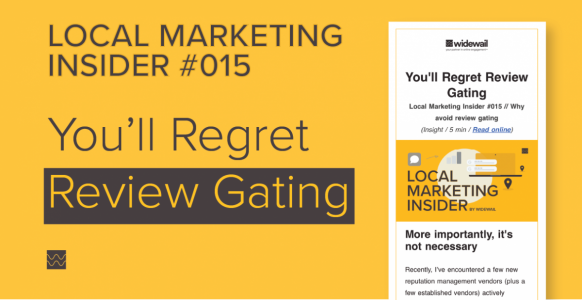- Feb 17, 2021
- 96
- 75
- Awards
- 4
- First Name
- Jake

More importantly, it's not necessary
Recently, I’ve encountered a few new reputation management vendors (plus a few established vendors) actively promoting what is known as “review gating” as a product feature.What is review gating?
The act of selectively soliciting reviews only from customers that you have qualified as happy.
How this works in practice:
- Customer sent survey > if happy > sent to leave a public review
- Customer sent survey > if unhappy > sent to private feedback channel
“Review filtering”
“Qualifying question”
“Private feedback collection”
“Those who respond positively get sent to a public forum”
In an effort to maintain trust and transparency online, this process has been explicitly prohibited by Google for a few years now.
Doing so can result in your review content being deleted in bulk. Thousands of reviews, gone in an instant. We’ve seen it happen before.
Because of this we highly discourage local businesses from attempting to review gate. Widewail’s services do not gate, and we’ve found doing so is not necessary to build a great reputation and grow your business via local search. I’ll explain why in this post.
Why risk your reputation - and just as important, your search rank?
Data is Overwhelmingly Positive
Analyzing 177,737 reviews from 2020, Widewail found 88% of all reviews are either 4-or-5-stars (without gating of course).There is a common misconception that if you actively solicit customer feedback the result will be a whole bunch of negative reviews, doing more harm than good.
In our experience, that’s just not how it plays out.
Contrary, we’ve found ratings get better when local businesses start asking for public customer feedback at scale. The average Invite client’s rating climbs +0.3-stars in the first few months (ex. from 4.4-4.7).
Under normal circumstances, the vast majority of local business experiences are positive, but without prompting customers and making it easy to leave a review, those positive experiences tend to be disproportionately underrepresented online.
Why?
Unhappy customers are more motivated to share. They will dig up your profile and make it hurt. Whereas your happy customers have moved on to other things.
By asking all customers and making it easy for them to leave a review, naturally (without gating), more happy customers get involved and ratings go up. A win-win.
Yes, you could avoid the whole issue and collect feedback privately, but as a result, you’d miss out on the increasingly valuable SEO benefits of gathering customer review content on Google and public other review platforms. A high volume of positive reviews helps organically increase your business’s visibility in local search engines.
Take Invite client Code Style Club for example:
- 39% increase in site visits
- 67% increase in phone calls
- 277% increase in search and map result appearance
Embrace the Negatives
Negative reviews are not something to be feared. With the proper techniques and perspective, they can be handled efficiently, effectively and appropriately. We cover negative review response techniques in this blog.The upside to negative reviews:
- When handled appropriately, you will publicly demonstrate to future customers that in the event they have a bad experience they will be treated with respect and an effort will be made to solve the problem.
- They add credibility to your positive reviews.
- They add authenticity to your online reputation.
- Feedback patterns can be used to improve the in-store experience.
"To the owner. My daughter read and 100% respected all your reviews, good or bad, and loved your responses to all of them. She knew your dealership was the place she wanted to go because of how you respond to all your reviews."
Assuming negative review volume is not out of control when handled professionally negative reviews can have some positive impact on your business.
To clarify, what is “out of control” in this context? As a benchmark, generally, we recommend <10% of your reviews be negative (3-stars or less).
As a broad guideline, 2-3 months with a negative review percentage over 10% should be an indication the in-store experience could be fine-tuned.
Thank you for reading Local Marketing Insider. Review gating may be tempting, but before pursuing the strategy I encourage you to consider the risks.
If you enjoyed this article, you can find the entire Local Marketing Insider catalog here. Also, to receive the newsletter 2x/month please consider subscribing.
See you in 2 weeks - Jake, Marketing @Widewail





